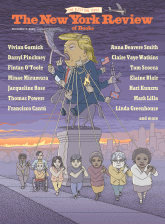The morning after Donald Trump’s election, everyone who had not voted for him probably woke up thinking, “How did we get here?” Nearly four years later, even when we ask it rhetorically, we are still marveling over the question, for which no satisfying answer has ever been found. How indeed did we get here? Everyone—economists, sociologists, political scientists—has a theory: Vietnam, rapacious capitalism, the digital revolution. And while I am usually the last person in the room to resort to theory, I nonetheless have one, too, which I’ll now throw in the ring.
For me, it all begins with the liberationist movements of the 1970s and 1980s; that is, the surprise uprising of blacks, women, and gays in a country that was still failing to deliver the political and social equality that had long been promised and long been denied. Convinced that the United States was a mature democracy, we feminists in particular were certain that the gross subordination under which American women lived, now articulated by hundreds of us, would tomorrow be acknowledged by thousands, and the day after that by millions. How could it be otherwise? Only people of serious ill will or intellectual deficiency or downright political greed would oppose the obvious. And after all, how many of them could there be?
We soon had our answer in the form of the formidable Phyllis Schlafly, the rock-ribbed Republican whose violent denunciations of the feminist movement we found both frightening and incomprehensible. For Schlafly, feminism was the Antichrist, and she would rather see America come apart at the seams than submit to our godless demands. She wanted America to remain—as God would have wanted it to remain—safe for Mom and apple pie. She wanted the protective laws that ensured inequality for women—state laws that limited the number of hours a woman could work in a week, for example—to stay in place. She wanted Roe v. Wade overturned. She said there was no such thing as rape in marriage and that labor-saving devices such as indoor clothes dryers had provided all the improvement in life that a woman needed.
What was sobering—and what sent us reeling—was the incredible response she received from a few million women, ordinarily apolitical, who now seemed to be living in active terror of social change, the idea of women living independent of marriage and motherhood having sent them over the edge. What very few on my side of the divide really understood was how primitive these issues actually were, and how far-reaching were both the fear and, yes, the despair they induced. Pretty soon many of us began to realize that the gulf between the women’s movement and Schlafly’s followers not only wasn’t going to narrow, it was going to grow steadily wider; and under its dividing influence American society (as all of us had ever known it) might begin seriously to come apart.
At this point an old-time revivalist movement began to sweep through the land, the kind that arises when a society is forced, like an individual, to face its own deepest conflicts retreats into the mindlessness of unreason. Within two decades there were evangelicals everywhere, prayer breakfasts in the White House, and Americans in unheard-of numbers announcing their belief in angels.
It was as though, having been forced into a soul-searching it could not sustain, the United States had decided instead to have a nervous breakdown. When Thomas Frank wrote What’s the Matter with Kansas? (2004), his book about the Midwest turning conservative, he wondered why hardworking farmers and blue-collar laborers were voting against their own interests, which he took to be economic. But they were in fact voting for what was now their own interest. The rallying cries “abortion!” and “gay marriage!”—uttered as warnings of threats to life and limb—said it all. The enormity of the fear and anxiety that they felt at the thought of welcoming into the democracy all those not like themselves was eye-opening.
I’ve never thought of myself as a patriot; still, it wasn’t until September 11 and the subsequent wars that I began to lose a light-heartedness about being American that I didn’t know I’d had until I lost it. Somewhere inside me, when reading about the human rights atrocities some other country was committing, I must always have been gratified to think that “America would never do that.” Now, of course, I know better. Still, it was not until Donald Trump became president that I could even imagine American democracy self-destructing. Now it seems a distinct possibility. Who knows what sort of damage done in the future will be traced back to these years? On that score, all bets are off.
But on most scores, all bets are off. I live from day to day, sometimes animated, sometimes really depressed, but mainly in a state of open-ended curiosity about how much of the damage I am going to see play itself out.
Advertisement



